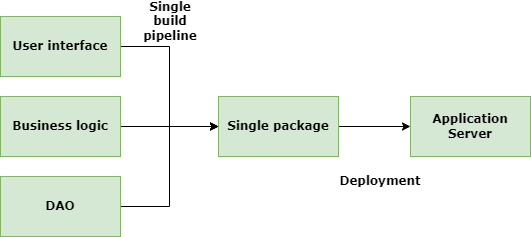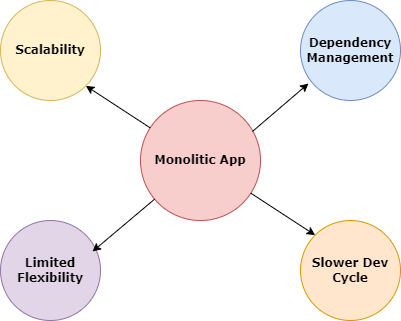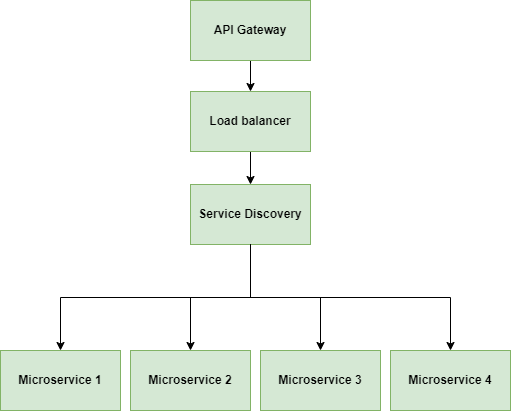Table of Contents
ToggleIntroduction
Choosing the right software architecture for your project is like laying a solid foundation for a building. Nail it, and the rest will naturally align. Get it wrong, and you could be in for a world of pain later on. In the world of software development, two primary architectural styles dominate the landscape: monolithic architecture and microservice architecture. Both have their strengths and weaknesses, and the choice between them can significantly impact your project’s success.
Understanding Monolithic Architecture

Monolithic architecture represents the conventional method of constructing software applications, where the entire system is developed as one cohesive, unified entity. All the components of the application, such as the user interface, business logic, and data access layer, are tightly coupled and interconnected.
Components of a Monolithic Application
A typical monolithic application includes the following components:
- User Interface (UI): The front-end part of the application that interacts with the users.
- Business Logic: The core functionality that drives the application, including data processing and decision-making.
- Data Access Layer: The component responsible for interacting with the database to store and retrieve data.
How Monolithic Architecture Works
In a monolithic application, all the components are bundled together into a single executable or package. This implies that any modifications or updates to a single component necessitate a complete rebuild and redeployment of the entire application

Advantages of Monolithic Architecture

Simplicity in Development and Deployment
A major benefit of monolithic architecture is its straightforwardness. Since everything is packaged together, it’s easier to develop, test, and deploy the application. There’s no need to worry about inter-service communication or managing multiple deployments. Spring Boot is an excellent framework which provide capability to develop and deploy Microservice applications. You can get learn more about Spring Boot here.
Performance Benefits
Monolithic applications often perform better than microservices because there’s no overhead associated with network communication between services. All the components interact directly within the same process, leading to faster execution times.
Easier Debugging and Testing
With all components in a single codebase, debugging and testing become more straightforward. Developers can easily trace issues across the entire application, and automated tests can cover the entire application in one go.
Unified Codebase
A monolithic architecture provides a unified codebase, making it easier for developers to understand the entire application. This can be particularly beneficial for smaller teams where everyone needs to be familiar with all parts of the code.
Disadvantages of Monolithic Architecture

Scalability Challenges
As the application grows, monolithic architecture can become difficult to scale. Scaling a monolithic application often involves replicating the entire application, which can be inefficient and costly.
Dependency Management Issues
In a monolithic application, all components are tightly coupled, which can lead to dependency management issues. Changes to one component can have ripple effects on other parts of the application, making it harder to maintain.
Slower Development Cycle
As the application becomes more complex, the development cycle can slow down. Making changes to a large monolithic codebase can be time-consuming, and deploying updates often requires downtime.
Limited Flexibility
Monolithic architecture limits flexibility in terms of technology choices. Since all components are bundled together, it’s challenging to introduce new technologies or frameworks without affecting the entire application.
Understanding Microservice Architecture

Microservice architecture takes a different approach. Instead of building a single, unified application, microservices break down the application into smaller, independent services. Every service handles a distinct functionality and can be developed, deployed, and scaled on its own.
Key Components of a Microservices-Based System
A microservices architecture typically includes the following components:
- Microservices: Small, independent services that handle specific tasks within the application.
- API Gateway: A central gateway that handles requests from clients and routes them to the appropriate microservices.
- Service Registry: A directory that keeps track of all the available microservices and their locations.
- Load Balancer: A component that distributes incoming requests across multiple instances of a microservice to ensure even load distribution.

How Microservices Work Together
In a microservices architecture, each service communicates with other services over a network, usually using RESTful APIs or messaging protocols. This allows each service to operate independently, with its own codebase, database, and deployment pipeline.

Advantages of Microservice Architecture

Scalability and Flexibility
Microservices excel in scalability and flexibility. Since each service is independent, you can scale individual services based on demand, rather than scaling the entire application. This allows for more efficient use of resources and the ability to handle varying levels of traffic.
Independent Development and Deployment
One of the key advantages of microservices is the capacity to develop and deploy each service independently. This means that different teams can work on different services simultaneously, speeding up the development process. Updates can be applied to individual services without impacting the whole application.
Improved Fault Isolation
Microservices offer better fault isolation. If one service fails, it doesn’t necessarily bring down the entire application. This makes the system more resilient and easier to maintain.
Technology Diversity
With microservices, you’re not limited to a single technology stack. Each service can be built using the most appropriate technology for its specific needs, allowing for greater innovation and experimentation.
Disadvantages of Microservice Architecture

Increased Complexity
The biggest downside of microservices is the increased complexity. Managing multiple services, each with its own codebase, deployment pipeline, and database, can be challenging. It requires a higher level of coordination and expertise.
Communication Overhead
Since microservices communicate over a network, there’s an inherent overhead associated with these interactions. This can lead to increased latency and the need for robust monitoring and logging to ensure smooth communication between services.
Data Consistency Challenges
In a microservices architecture, each service typically manages its own database, leading to potential data consistency challenges. Ensuring that data remains consistent across services requires careful planning and the use of distributed transaction patterns.
DevOps and Monitoring Demands
Microservices require a mature DevOps culture and sophisticated monitoring tools to manage the complexity of multiple services. This can increase the operational burden on teams and necessitate a higher investment in infrastructure and tooling.
Key Differences Between Monolithic and Microservices
Architectural Structure
- Monolithic: Single unified codebase, tightly coupled components.
- Microservices: Multiple independent services, loosely coupled.
Scalability and Performance
- Monolithic: Scalability is challenging and usually involves scaling the entire application.
- Microservices: Easier to scale individual services, leading to more efficient resource usage.
Development and Deployment Processes
- Monolithic: Single deployment pipeline, slower updates.
- Microservices: Independent deployments, faster updates.
Maintenance and Evolution
- Monolithic: Harder to maintain as the application grows.
- Microservices: Easier to maintain, but requires more coordination.
When to Choose Monolithic Architecture
Best Suited for Smaller Projects
Monolithic architecture is often the best choice for smaller projects with a limited scope. If your application doesn’t require complex scaling or has a smaller user base, monolithic can be a more straightforward and cost-effective option.
Limited Resources and Team Size
If your team is small and resources are limited, a monolithic architecture can be easier to manage. The simplicity of having everything in one place reduces the need for specialized skills and tools.
Projects Requiring Quick Delivery
For projects that need to be delivered quickly, monolithic architecture allows for faster development and deployment. The lack of inter-service communication and the unified codebase make it easier to get up and running.
When to Choose Microservice Architecture
Best Suited for Large, Complex Projects
Microservice architecture shines in large, complex projects where scalability, flexibility, and fault tolerance are critical. If your application is expected to grow and evolve over time, microservices provide the agility needed to adapt.
Need for Scalability and Flexibility
If your project demands the ability to scale rapidly or handle varying levels of traffic, microservices are the way to go. The independent nature of each service allows for more targeted scaling and better resource management.
Projects with Diverse Technology Stacks
In cases where different parts of the application require different technologies or frameworks, microservices offer the flexibility to use the best tool for each job. This can lead to better performance and more innovative solutions.
Case Studies and Real-World Examples
Example of a Successful Monolithic Architecture
One example of successful monolithic architecture is early versions of LinkedIn. Initially, LinkedIn was built as a monolithic application, which allowed the team to iterate quickly and deliver new features to users. Over time, as the platform grew, they transitioned to a microservices architecture to handle the increased complexity.
Example of a Successful Microservices Architecture
Netflix serves as an excellent example of a company that effectively implemented microservices. Faced with the challenge of scaling to millions of users worldwide, Netflix broke down its monolithic application into hundreds of microservices. This allowed the company to scale individual services independently, ensuring a smooth user experience even during peak times.
Transitioning from Monolithic to Microservices
Challenges in Transitioning
Transitioning from a monolithic architecture to microservices is not without challenges. The process can be intricate and lengthy, demanding meticulous planning and execution. Key challenges include data migration, ensuring service reliability, and managing the increased complexity of multiple services.
Best Practices for a Smooth Transition
- Start Small: Begin by identifying and extracting a few key services from the monolith. This allows you to test the waters and refine your approach before fully committing.
- Automate Everything: Invest in automation tools for deployment, testing, and monitoring to manage the increased complexity.
- Focus on Culture: Foster a DevOps culture within your team to ensure smooth collaboration between development and operations.
Common Misconceptions About Microservices
Microservices Always Outperform Monolithic Architecture
While microservices offer many advantages, they don’t always outperform monolithic architecture. The benefits of microservices, such as scalability and flexibility, come with trade-offs in complexity and operational overhead. For smaller projects, a well-designed monolithic application can be more efficient.
Microservices Are Only for Large Companies
There’s a common belief that microservices are only for large companies like Netflix or Amazon. However, smaller organizations can also benefit from microservices, especially if their projects require scalability, flexibility, or involve multiple technology stacks.
Conclusion
Choosing between microservice architecture and monolithic architecture is not a one-size-fits-all decision. It depends on your project’s size, complexity, and specific requirements. Monolithic architecture offers simplicity and ease of use, making it ideal for smaller projects with limited resources. Conversely, microservices offer scalability, flexibility, and resilience, which are ideal for larger, more intricate applications. By evaluating the advantages and limitations of each approach, you can make a well-informed choice that aligns with your project’s requirements.
FAQs
1. What is the main difference between microservices and monolithic architecture?
The main difference is that monolithic architecture involves building a single, unified application, while microservices break down the application into smaller, independent services that can be developed, deployed, and scaled separately.
2. Can a small startup benefit from microservices?
Yes, a small startup can benefit from microservices, especially if the project requires scalability, flexibility, or involves multiple technology stacks. However, the increased complexity should be carefully considered.
3. What are the biggest challenges when adopting microservices?
The biggest challenges include managing increased complexity, ensuring smooth communication between services, maintaining data consistency, and the need for a mature DevOps culture.
4. How do microservices handle data consistency?
Microservices typically handle data consistency through eventual consistency models, distributed transactions, and careful design of data ownership across services.5. Is it possible to mix monolithic and microservices in one project?
Yes, it is possible to have a hybrid approach where some parts of the application are monolithic while others are microservices. This can be a practical approach during a transition phase or when certain parts of the application benefit from different architectural styles.
So, there you have it – a breakdown of monolithic and microservice architectures! I hope this helps you decide which path is best for your project. Remember, there’s no one-size-fits-all answer, so choose what works best for you. Let us know if you have any questions – we’re here to help!


One Response